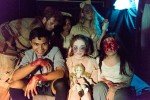Audience members of “The Cure” received a list of disclaimers via email before attending the show.
The disclaimers warned audience members of complete darkness, intimate encounters with cast members, mature themes and proximity to strangers. It also asked for audience consent to being physically touched by performers.
“The Cure,” which ran Oct. 28 and 29 in Macgowan Hall, is a devised immersive theater experience put on by Act III Theatre Ensemble. It transformed a small black box theater into the Macgowan Manor Asylum, complete with various bedrooms and patients. Audience members did not have seats – instead, a patient posing as a nurse gave them surgical masks and tasked them with helping treat the patients, who were free to move around the space and interact with the attendees.
The process of creating the show began several weeks ago, after cast members were chosen through an audition process in September. The cast and crew knew they wanted to set the experience in a psychiatric hospital but didn’t have a script, said Jake Levy, the show’s director and a fourth-year theater student. Instead, through the rehearsal process, they worked together to build characters and create the story.
“When audience members attend this production, they see this very rich character development for all our actors, which is really exciting because then the world is sort of a second thought,” Levy said. “They’re so ingrained in these characters that the world just becomes painted onto it, which is beautiful.”
Levy used a variety of acting techniques and exercises to help cast members begin their character creation. Second-year theater student Anusha Shankur, who plays a nurse in the show, said a large part of creating the characters was reacting to others’ acting choices instead of making individual choices, thus creating a balance in the narrative.
“Everyone has kind of violent backstories,” Shankur said. “But a lot of the decisions that we made are mainly to inform ourselves about our character and characterization rather than to tell the audience. It was just a lot of introspection.”
Fourth-year theater student and stage manager Scottie Nevil helped organize the different thoughts and ideas generated by the cast and crew as they built the show together. Although Nevil had worked on similar shows before, the experience required meticulous observation as it was largely improvised, she said.
“You can come up with an idea one rehearsal and then next rehearsal, completely scratch it, so it’s about managing the collection of ideas and then managing which ones stay and which ones go,” Nevil said. “It’s been trying to find and keep a through line, whether that is how do we want the audience to feel or what do we want the audience to take away from this or what do we want our central message to be.”
The cast of “The Cure” performed a total of four shows, two on Saturday and two on Sunday, each with around 16 audience members. Audience members were seated in a waiting room and then brought into the performance space a few at a time by a bloodied, barefoot nurse.
The psychiatric hospital set featured a dimly lit recreation room, filled with a TV and chairs, as well as several separate rooms that belonged to the patients. Throughout the duration of the 45-minute experience, audience members interacted with various patients, each with their own idiosyncrasies.
One patient, who went by the name of Maddox, took audience members to visit a blind patient under the guise of helping change her bandages. Once the audience arrived in the room, Maddox placed bandages over their eyes, asking if they knew “the good word” before performing a prayer circle. Other patients played “Ring Around the Rosie” or instructed the audience to scrub the walls with sponges, all while becoming increasingly paranoid about patient disappearances within the psychiatric hospital.
The experience culminated in a five-minute challenge for audience members to find clues hidden around the set, to discover a cure for the patients’ conditions and to escape the Macgowan Manor Asylum. In the final moments a garage door opened, revealing the patients outside, finally freed, before they ran off into the night.
Second-year theater student Dean Vicedo attended the last show Sunday and described the experience as terrifying and intense.
“I didn’t know what to expect, I really didn’t because I didn’t hear much about rehearsal process or anything like that. It was a lot to take in, because there’s not that much theater like that out there,” Vicedo said. “It was a wild ride, I can tell you that.”
The horror elements of the Halloween weekend performances played into the atmosphere of the season, something Nevil hoped audience members would embrace during their 45-minute horror experience.
“I hope everyone just has a lot of fun and feels comfortable enough to forget the world they are in before they enter into the world of the show,” Nevil said. “I really hope people come to this space and just feel inclined to surrender themselves to it.”
